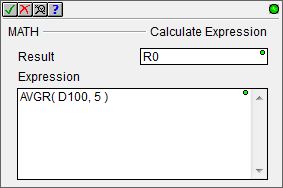Topic: DMD0157
AVGR - Average of a Range of Values
This instruction can only be used in the Expression parameter of the Calculate Expression (MATH) instruction.
The Average of a Range of Values (AVGR) math function calculates the average of the values in the specified range of variable locations. This function has two parameters as follows:
The first parameter
designates the first location in the range of values. This can be any
readable bit data-block location or readable numeric data-block location.
The second parameter specifies the number of successive locations that are in the range. Note that this value is a count value, it does NOT specify the ending location. This can be any constant value from 1 to 65535, or, any regular math expression - for example (D3 - D1), or any readable numeric location.

This function always evaluates to a floating-point values.
Note: If the second parameter (Range) is 0, the Result will be 0 and ST132 (Argument Out of Range) will be ON.
Note: If the second parameter exceeds the size of the data block , the result will be the sum of the values up to the last variable in the block and ST132 (Argument Out of Range) will be ON. For example, assume the block of WX locations has a range of WX0 to WX255. The result of AVGR(WX250, 10) would be the average of the values in WX250 through WX255, and ST132 (Argument Out of Range) will be ON.
See Also:
AVGR - Average of a Range of Values
Related Topics:
Rung Example:
